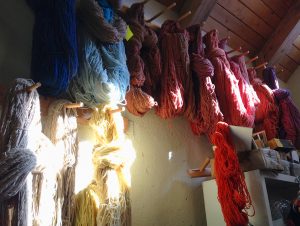
Centinela Traditional Arts, Chimayo, NM
When I pulled into the driveway of Centinela Traditional Arts in Chimayo, NM, it was a relief after slaloming within a string of cars along a winding ribbon of two-lane black-top lined too close for comfort by gates and houses. Google maps did not indicate many landmarks along this road and it was by chance that I saw the sign and that there was no oncoming car at the moment I needed to turn left into the driveway or overshoot.

Spinning “prepared roving” wool onto a spinning wheel
I met Lisa Trujillo and her daughter Emily. They showed me around the shop and showed me newly shorn churro wool, wool that was “in the grease” (ready to be washed), and “prepared roving” (wool that has been washed and is ready to be spun) and Emily demonstrated the spinning of prepared roving wool on a spinning wheel.
Lisa took me out to the farm out back where the family keeps a small herd of churro sheep. They use this wool for all of their traditional weaving.

Churro sheep at the Centinela Traditional Arts farm
Churro was the original breed of sheep brought by the Spanish to this region in the 16th century, the wool from which has been used for weaving since that time. The sheep are of varied colors, accounting for the natural white (cream) and the range of natural colors in the wool of grays and browns to almost black. The fine undercoat is used for weft wool which makes the surface of a weaving. The coarse outer coat is strong and used for the warps (structure) of a weaving. I have seen photographs of this breed, always with symmetrical horns. But these sheep had horns of every size, pointing in all directions, making them very cute to look at.
Irvin Trujillo took me through a brief history of Rio Grande weaving, showing me examples from the textiles hanging on the walls. His is the seventh generation family of weavers who have passed their craft and dye recipes down to each succeeding generation. He showed me photographs of wedding blankets, woven and gifted within his family, which are Rio Grande textiles that are mostly natural white. He took me through the weaving room where three enormous looms, each with weavings in progress, are set up so they almost touch corner to corner along three walls of the room.

Outdoor dye shed
Last we looked through the outdoor dye shed where the family dyes all of the wool they use in traditional weavings using only natural dyes. Lining one wall were very large stock pots holding a variety of natural dyestuff materials and skeins of wool bathing in the dyes.

Chamisa dye bath
Some of the dyeing in process included chamisa (the blooms from rabbit brush which produce yellows) and indigo (blues). The intensity of the dye depends partly on how long the wool remains in the bath, from overnight to several days. Irvin showed me some of the dyestuff materials: cochineal (insects that produce a brilliant red), lumps of indigo (processed from the native Mexican plants), and brazilwood (pieces of heartwood that make reddish tans to golden yellows). Upon removal from the dye bath, the wool dries, and then is rinsed until the water runs clear.

Natural-dyed churro wool
In their shop hung many skeins of churro wool, natural-dyed in a myriad of colors, waiting to be used in weavings.
